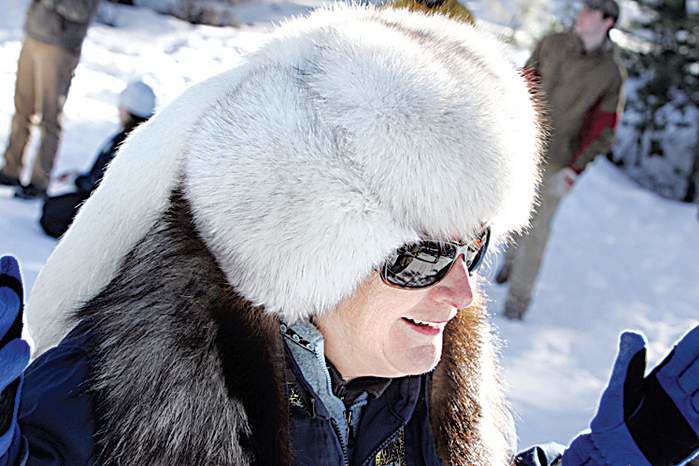Sled dogs race in Chemult
Published 4:00 am Monday, January 19, 2009

- Wearing a blue fox hat and a wolf-and-wolverine ruff, Lin Neumann, of La Pine, talks about being retired from sled-dog racing, while watching the Chemult Sled Dog Races.
CHEMULT —
The sign painted on a truck parked at the Walt Haring Sno-park north of Chemult on Sunday said it all:
“Dog Sledding: the world’s loudest silent sport.”
In the parking lot, dozens of dogs created a riot of yipping and barking and snarling, lunging at passers-by and tugging at their chains.
But once these dogs hit the course, it’s all quiet in the forest save for the soft crunch of paws on snow, the skidding sled runners and a barely audible panting.
Now in its 15th year, the Chemult Sled Dog Races attract a range of competitors, from long-bearded men in greasy jeans to women wearing fur, ski pants and jackets that wouldn’t look out of place on the streets of Aspen. The dogs vary greatly, too, with classic huskies racing alongside dogs that look more like extra-fit house pets.
Lin Neumann, a retired musher from La Pine, explained that the era of Alaskan and Siberian huskies dominating dog-sled racing has come to an end.
In the late 1990s, a Swedish musher named Egil Ellis came to the United States with a team of unusual-looking dogs, a mix of pointer, husky and greyhound, Neumann said.
When Ellis won the Open North American Championship race in Fairbanks, Alaska, for the first time, other racers thought it was a fluke, Neumann said. After he won the race four years in a row, other racers and breeders started switching to new breeds.
Bad knees forced Neumann into retirement two years ago, ending a career of more than 30 years, but she said she still likes to get out to watch the races.
Dog-sled racing is a tight-knit fraternity, she said, where you run into the same people again and again over the years.
When she and her husband, Dan, went to the championship race in Fairbanks a few years ago, people they hadn’t seen in 25 or 30 years spotted them in the starting chute and came over to visit, she said.
On Sunday, race announcer Richard Kilbury, of Chemult, said dog-sled racing has a way of sucking you in. A U.S. Forest Service employee in the Chemult Ranger District for the last 19 years, Kilbury was brought in to supervise the races when they first began, and eventually found himself with a microphone in hand, calling out the names of the competitors.
Sitting under an awning in a hat topped by the stuffed-animal head of a husky, Kilbury said he never imagined he’d end up as a sled-dog commentator.
“It’s just, you’re in the wrong place at the wrong time,” he said. “That happened about 13 years ago, and I’ve been doing it ever since.”
T.W. Landis, of Reno, Nev., said the coordination of his black fur Soviet military hat and his team of Siberian huskies is more coincidence than anything. A retired military contractor, he said he acquired the hat as part of the “spoils of war” when the Soviet Union fell, but didn’t pick up his interest in dog-sled racing until some years later.
The breeder who sold Landis his huskies revealed that some of his dogs were racing, and Landis was immediately intrigued. He’d run car and motorcycling teams in the past, and so far, he’s found dog-sled racing to be much the same — costly.
“It’s like any other racing,” Landis said. “How do you earn a small fortune in dog-sled racing? Start with a big (fortune).”
The money issue is a constant lament for organizers and competitors. Race Marshal Alan Iverson, of Medford, said the slowing economy has hurt dog-sled racing, with many teams choosing to travel to fewer races and others giving it up entirely.
Although attendance at the Chemult race was down this year, Iverson said the event has a core group of committed volunteers, and if everything works out right, next year it will have a prominent corporate sponsor.
Will Wanlass, of Redmond, said when he first started racing back in the mid-’70s, nearly all of the races had deep-pocketed sponsors behind them. Just a few years ago, Chemult had a $15,000 purse, Wanlass said, but now it’s down to $2,500.
When he started with three huskies he picked up at the San Jose, Calif., pound and an old sled he bought for $100, it was a hobby where it only took a few good races to cover your expenses or even make money, he said.
Wanlass said he’s put half a million miles on his truck with a kennel on the back, chasing races across the West, and even though there’s no money to be earned, he doesn’t plan to quit. The thrill of racing and the generosity of people on the race circuit are enough to make it worth his while, Wanlass said.
“Everybody is willing to help everybody out,” he said. “A lot of sports aren’t like that.”
Racer Scott Campbell, of Blackfoot, Idaho, said he too is mostly racing for the fun of it these days. Campbell had a trying weekend, having to stop six times along the four-mile course to untangle his team on Saturday, and crossing the finish on foot Sunday when his dogs tried to veer off the course just short of the finish line. A serious racer in the early 1990s, Campbell said his current dogs haven’t been to enough races to learn not to panic when they approach a crowd of spectators.
Campbell ended up sixth when Saturday and Sunday’s times were tallied up, one spot out of the money. It takes a perfect run to win, he said, and it’s the unending search for that perfect run that keeps him racing.
“It’s a fever,” Campbell said. “You catch the fever, and you got problems.”





